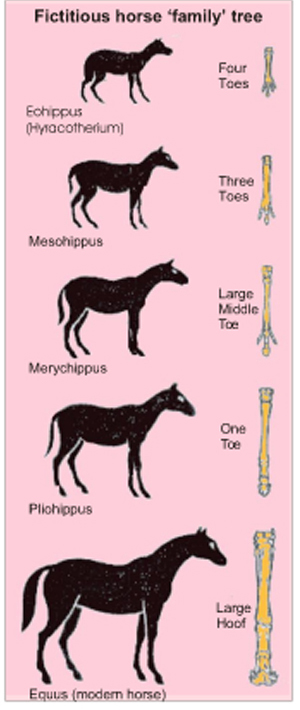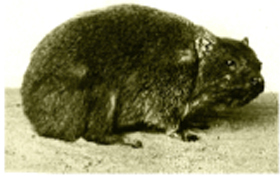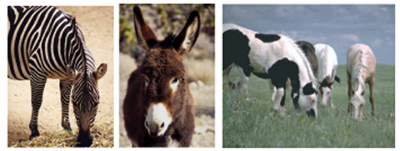HORSE NON-SENSE
ONE of the most commonly-presented 'proofs' of evolution is the so-called horse series. It is claimed that modern horses have evolved during the last 55 million years from a tiny creature that was about 30 cm (1 foot) tall at the shoulder.
 This is how one book describes it: 'One well-known example of evolution is the history of the horse. Geologists have found fossil remains that reveal the ancestry of the modern horse right back to the Eocene epoch, 55 million years ago.'1 The series, which is often depicted by a family tree like the one on the right, is said to have begun with four-toed Hyracotherium sometimes known as Eohippus (dawn horse), and ended with the modern one-toed horse Equus, but there are a number of serious flaws in this theory.
This is how one book describes it: 'One well-known example of evolution is the history of the horse. Geologists have found fossil remains that reveal the ancestry of the modern horse right back to the Eocene epoch, 55 million years ago.'1 The series, which is often depicted by a family tree like the one on the right, is said to have begun with four-toed Hyracotherium sometimes known as Eohippus (dawn horse), and ended with the modern one-toed horse Equus, but there are a number of serious flaws in this theory.
FIRST HORSE NOT A HORSE
When the first fossil bones of Hyracotherium were found in Europe in the mid-19th century, Richard Owen, the well-known anatomist and biologist, gave them this name (which means 'hyrax-like beast') because the fossils resembled the skeleton of the rabbit-like hyrax (coney) which lives in parts of Africa today. There is really no evidence whatsoever to link this creature with horses. It appears to have been nothing more than a hyrax. So the horse family tree has a false base.

A hyrax.

Variations within the horse family.
NO FOSSIL SUCCESSION
One evolutionist, N. Heribert-Nilsson, admitted: 'The family tree of the horse is beautiful and continuous only in the textbooks.'2 The remains of the various fossil horses used in these diagrams have not been found one above the other in successive rock layers. Fossils of the four-toed Eohippus have been found in surface layers alongside those of two types of modern horses.3 In Nebraska, USA, the three-toed and one-toed species are preserved in the same formation4, and in South America, fossils of the one-toed horse are found below those of the three-toed variety.5
The number of ribs varies within the 'horse series', up and down, between 15, 19 and 18. The number of lumbar vertebrae also changes from 6 to 8 and then back to 6. These facts do not support the theory that one type of horse evolved from the other.
HORSES VARY IN SIZE
The idea of large horses evolving from small horses is rather illogical anyway, because modern horses vary tremendously in size, from the Fallabella horses of Argentina fully grown at 43 cm high to the massive Clydesdale. If these were found only as fossils, would evolutionists conclude that the Clydesdale had evolved from the Fallabella? The horse family also contains such veriants as zebras, donkeys and ponies.
NO ADVANTAGE TO LOSE TOES
Why would a reduction in the number of toes have conferred any evolutionary advantage on horses? Dr. Evan Shute commented: 'This ignores the efficiency of such runners as the antelope (on 2 toes), the cheetah and the dog and wolf (five toes before and 4 behind). It seems very doubtful that a one-toed horse could outstrip such a 2-toed or 5-toed animal in a race.'6
CONCLUSION
We may conclude, therefore, that there is no evidence that horses have ever been anything other than horses, and that these beautiful creatures, so useful to the human race, have not evolved, but were created by God, who long ago asked Job: 'Do you give the horse its strengths, or clothe his neck with a flowing main?' (Job 39:19).
REFERENCES:
- Mark Lambert, Kingfisher Guide to Fossils, Ward Lock, 1978, p. 26.
- N. Heribert-Nilsson, Synthetische Aribidung, Gleerup, Sweden: Lund University, 1954.
- National Geographic, Vol. 1, No. 1, January 1981, p. 74.
- Francis Hitching, The Neck of the Giraffe: Where Darwin Went Wrong (New Haven, CT, Ticknor & Fields, 1982) p. 30.
- A. S. Romer, Vertebrate Paleontology, 3rd edition, Chicago University Press, 1966.
- Evan Shute, Flaws in the Theory of Evolution, Craig Press, New Jersey, 1961, p. 201.
Factsheets published regularly by Creation Resources Trust, P.O. Box 3237, Yeovil, BA22 7WD
(Registered Charity No. 1016666)© 2003 www.c-r-t.co.uk

